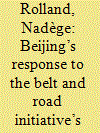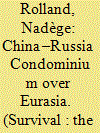|
|
|
Sort Order |
|
|
|
Items / Page
|
|
|
|
|
|
|
| Srl | Item |
| 1 |
ID:
166796


|
|
|
|
|
| Summary/Abstract |
Two speeches given by Xi Jinping in late 2013 – one in Kazakhstan, one in Indonesia – set the “Belt and Road Initiative” (BRI) in motion. What started as a continental Silk Road Economic Belt and a 21st century Maritime Silk Road embracing the Eurasian landmass from land and sea has since then expanded to include the African, South American and Oceanian continents, as well as the Arctic, space and cyberspace. The Belt and Road has become so ubiquitous in China’s external discourse and practice that it is now almost impossible to distinguish it from Beijing’s foreign policy.
|
|
|
|
|
|
|
|
|
|
|
|
|
|
|
|
| 2 |
ID:
163590


|
|
|
|
|
| Summary/Abstract |
China and Russia share similar views of what a future Eurasian order should look like.
|
|
|
|
|
|
|
|
|
|
|
|
|
|
|
|
| 3 |
ID:
154095


|
|
|
|
|
| Summary/Abstract |
Since its unveiling at the end of 2013, China's “One Belt One Road” initiative, or BRI for Belt and Road Initiative, as it is now officially known11. The official standardized English translation of 一带一路 ‘yidai yilu’ became “Belt and Road Initiative” in 2015, after the publication of a joint statement by the National Development and Reform Commission, the Ministry of Foreign Affairs and the Ministry of Commerce, specifically demanding that “initiative” should be in the singular instead of the plural form, and that the words “strategy”, “project”, “program” or “agenda” should not be used. See Xie Tao, “Is China’s ‘Belt and Road’ a Strategy?” The Diplomat, December 16, 2015, http://thediplomat.com/2015/12/is-chinas-belt-and-road-a-strategy/.
View all notes
—an awkward label that does not do justice to the poetry of its Chinese name, yidai yilu—has clearly emerged as one of President Xi Jinping's top priorities. The sheer size and ambition of the project, to which the regime has already committed substantial financial, diplomatic, and intellectual resources, gives it the potential to become one of the defining economic and political constructs of the first half of the 21st century. Designed to stimulate economic development by dramatically enhancing regional interconnectivity, the BRI aims to integrate the world's largest landmass—from Vladivostok to Lisbon, from Moscow to Singapore—through a dense network of both “hard” and “soft” infrastructure all linked to China (from transportation, telecommunications, and energy infrastructure to financial integration and political coordination). If the project succeeds as Beijing hopes, it will transform Eurasia's geopolitical landscape and cement China's position as the preponderant regional power.
|
|
|
|
|
|
|
|
|
|
|
|
|
|
|
|
|
|
|
|
|